Sales reps could be missing out on artificial intelligence (AI), which 85% of salespeople say makes sales prospecting efforts more effective.
Working in the sales industry is a constantly evolving experience. You must adapt to the current technology landscape and changing buyer preferences. Data and sales facts taken from reps, prospects, and customers paint a picture of what buyers are looking for and what sales teams are doing—allowing you to effectively adjust your operations for improved performance. Here, we explore 29 sales statistics to help guide your sales strategies in 2024.
Highlights
- Artificial Intelligence (AI) plays a critical role in the sales process, particularly sales prospecting, productivity, and training.
- Sales reps and managers are leveraging customer relationship management (CRM) systems and other tools to improve their workflow, performance, and overall operations.
- Sales have become omnichannel, expanding in social media and other digital channels.
- A sales team cannot stand alone without collaborating with customer service and marketing teams.
Sales Prospecting Statistics
Sales prospecting involves seeking early-stage leads through online research, connecting at professional events, or asking for referrals. This step is required to fulfill the stages of the sales process and should be a top priority to produce high-quality leads with robust deal-closing rates. Below, we share sales stats regarding how teams feel about prospecting and opportunities to connect with these potential leads.
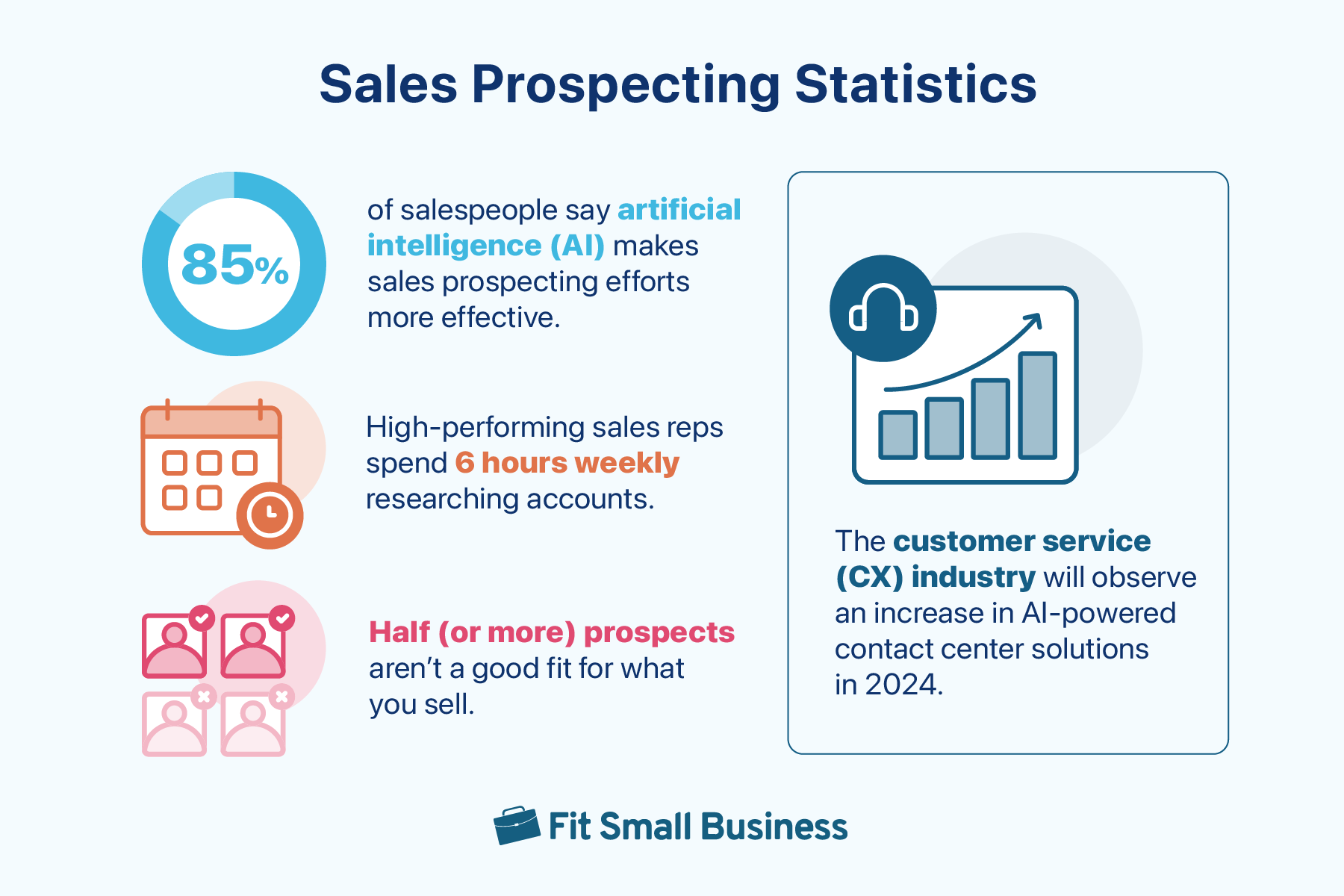
1. 85% of salespeople say artificial intelligence (AI) makes sales prospecting efforts more effective.
Takeaway: One of the most critical steps in the sales process is prospecting. Adopting AI can help with lead scoring and qualification as well as outreach content writing and personalization. Customer relationship management (CRM) software programs with AI capabilities use machine learning (ML) to identify the highest quality leads in the sales pipeline. This is true from high-volume data points and predetermined custom scoring criteria.
(Source: HubSpot)
2. The customer service (CX) industry will observe an increase in AI-powered contact center solutions in 2024.
Takeaway: This finding highlights how generative AI empowers human customer service and sales reps with continuous support during live chats and customer calls. Sales agents determine the purchase intent, provide real-time, step-by-step customer assistance, and detect customer motivations using AI. As a result, contact center managers will gain valuable insights into customer interactions to better assist reps in providing personalized services to their customers.
(Source: Genpact)
3. High-performing sales reps spend 6 hours weekly researching accounts.
Takeaway: Prospecting is a critical aspect of a sales process, which involves researching accounts or individual contacts. Sales reps can reduce the hours spent on finding prospects by using AI tools (like Zoho CRM’s Freddy AI feature). These tools can extract lead data across your communication channels through system or app integration with your business email, social media, and other digital platforms.
(Source: Revegy)
4. Half (or more) prospects aren’t a good fit for what you sell.
Takeaway: Imagine how much time is wasted when half of all the prospects you pursue aren’t a good fit for your product or service. Work with your marketing team to create customized segments of your audience. Tailor customer personas to hone in on your ideal buyers and lead generation strategy. For more information, read our article about customer personas and download a free template to get started.
(Source: Sales Insights Lab)
Pro tip: CRM platforms like Freshsales offer lead scoring tools to help you see which leads are the best opportunities. Lead scoring quantitatively measures a lead or deal based on customizable events and traits like interactions with your brand and solution fit. You can prioritize your efforts based on which opportunities appear the strongest.
Sales Enablement Statistics
Sales enablement involves providing technology, processes, and information to help sales reps improve their knowledge and efficiency. Sales management and leadership use enablement initiatives such as coaching, sales training, marketing resources, or software to improve the overall performance of their sales teams. Below, we share stats that prove the effectiveness of enabling your sales operation.

5. Sales enablement correlates with a 15% improvement in lower-performing reps.
Takeaway: As you evaluate the performance of your sales reps, look at whether or not you’re supporting them with the software tools and sales knowledge they need to perform at a high level. Enhancing your sales enablement could be the key to significantly improving a less-than-average sales rep’s production.
(Source: SaaS Worthy)
Pro tip: Implement effective ways to increase your CRM adoption and get your sales team’s full support for utilizing a CRM to handle your sales activities. For instance, try finding out the CRM features they prefer to use through a survey and conduct regular CRM training. Check out our guides on how to choose a CRM solution and the best methods to foster CRM adoption to help get you started on the right foot.
6. 76% of companies report a 6% to 20% increase in sales after implementing sales enablement initiatives.
Takeaway: Teams dedicated to sales enablement inevitably see revenue growth. Automation software, knowledge of sales techniques, and collaborative tools make reps more efficient and generate more leads. Additionally, leaders can guide them through the sales process faster—ultimately increasing revenue. The key is finding which parts of your sales operation need enablement and selecting the right solutions.
(Source: SaaS Worthy)
7. Over half of sales leaders implemented a new process in the past 120 days.
Takeaway: Enablement doesn’t need to arise through coaching or technology. Sales facts and statistics show that improving sales numbers comes from process or workflow adjustments. For example, many organizations switch to outsourced lead generation by purchasing lead data from a provider rather than conducting in-house research. This introduces a new process of determining targets, purchasing data, assigning leads to reps, and starting initial outreach.
(Source: Spekit)
8. Most reps spend 3 to 11 hours weekly looking for answers about sales tools, processes, or information
Takeaway: Investing in an enablement tool isn’t enough. For every new software, process, information set, or sales technique you are adopting, it’s also crucial to provide comprehensive and early sales training and resources to your team. This instruction should clearly outline when and how to use the new solution, along with accessible avenues for additional support. As a result, sales reps become more product knowledge-equipped and efficient in their roles.
(Source: Spekit)
Lead Management Statistics
Lead management involves generating, qualifying, and nurturing leads in your sales pipeline to move them toward a purchasing decision. It also encompasses organizing your lead information, such as contact data and pipeline status, in contact management software like a CRM system or alternative solutions such as spreadsheets or project management tools.
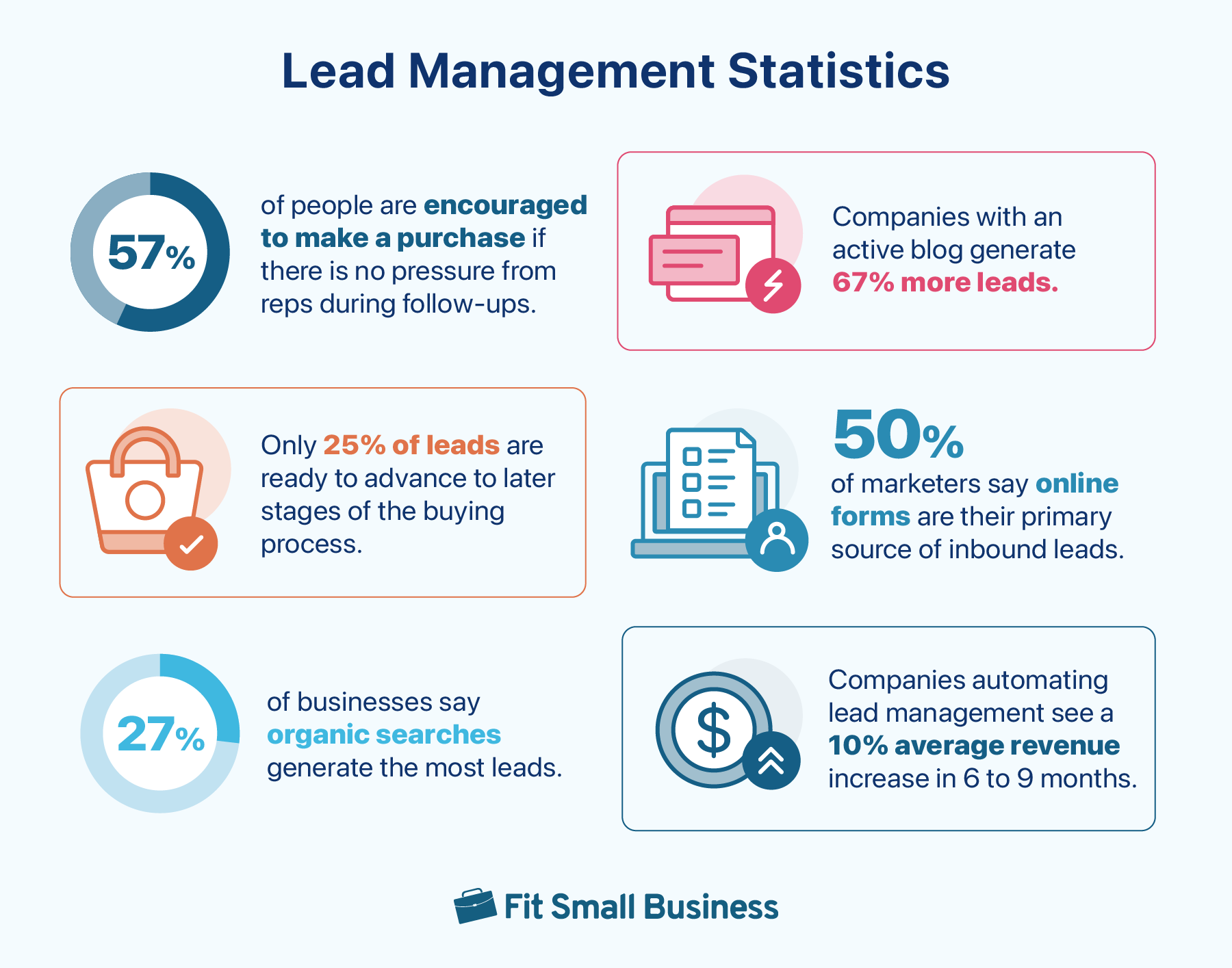
9. 50% of marketers say online forms are their primary source of inbound leads.
Takeaway: Many organizations use web forms as a top source for collecting inbound lead information. Similar sales follow-up statistics imply that marketing and sales teams should leverage online forms and collaborate on content and search engine optimization (SEO) strategies. Sales teams can integrate web forms into their websites so prospects can submit inquiries and reps can receive real-time alerts for quick follow-up.
(Source: WP Forms)
10. 57% of people are encouraged to make a purchase if there is no pressure from reps during follow-ups.
Takeaway: It’s no surprise most people don’t respond well to pushy salespeople. Reps should prioritize building relationships during their lead nurturing activities by aiming to understand their pain points and then customizing a solution that fits the prospect’s unique needs. Additionally, while following up with prospects is important, be methodical to avoid over-contacting and hassling leads.
(Source: Invespcro)
11. Only 25% of leads are ready to advance to later stages of the buying process.
Takeaway: After all a sales team’s lead generation efforts, the percentage of wins is low. Hence, it’s important to track the customer’s stage in the sales funnel. Sales reps can use sales data analytics in their CRM system to determine the lead’s stage in the buying process to take the right next step. Artificial intelligence (AI) assistants in CRM assist sales reps generate lead nurturing content like emails to move prospects in the bottom funnel and successfully close a deal.
(Source: WP Forms)
Want more sales statistics, specifically about the business-to-business (B2B) buying process? Check out our full article about B2B sales trends.
12. Companies automating lead management see a 10% average revenue increase in 6 to 9 months.
Takeaway: Many lead management automation tools foster revenue increases for your business. For instance, we mentioned how lead scoring is an automated tool for qualifying an opportunity. Lead nurturing can also be automated through email drip campaigns in popular products like Zoho CRM. Users can create rules for content types and when an email is deployed to a certain lead, depending on the lead’s behaviors.
(Source: WP Forms)
13. 27% of businesses say organic searches generate the most leads.
Takeaway: Most inbound leads come through a website form. But how are they getting to your website? Not surprisingly, organic online searches are where many people look. You can dramatically improve your website traffic by creating an effective search engine optimization (SEO) strategy and using the best SEO tools. Sales teams should obtain knowledge of SEO frameworks and search keywords to help reps better understand prospect lingo and pain points.
(Source: Ruler Analytics)
14. Companies with an active blog generate 67% more leads.
Takeaway: Content marketing is an excellent small business practice that involves creating articles, videos, podcasts, or reports on issues and solutions relating to your target audience. It can push to get leads interested in how your brand can assist them. Generating two-thirds more leads simply by drafting and publishing a weekly or monthly article is a no-brainer as long as there is follow-up by your reps after leads are generated.
(Source: LinkedIn)
Pro tip: HubSpot is an excellent CRM system with robust marketing and content management system (CMS) tools. In addition to managing sales, users can create and publish content for their website or social media pages directly from the CRM platform. Additionally, there are built-in SEO tools and a free blog idea generator, like HubSpot’s free AI content writer, to add even more content value.
Sales Productivity Statistics
Many leaders find it challenging to understand how sales reps spend their time as well as the key indicators of solid production and performance. Below, we dive into sales closing statistics, sales call statistics, and other related sales stats that you can use to optimize the productivity and efficiency of your sales team.
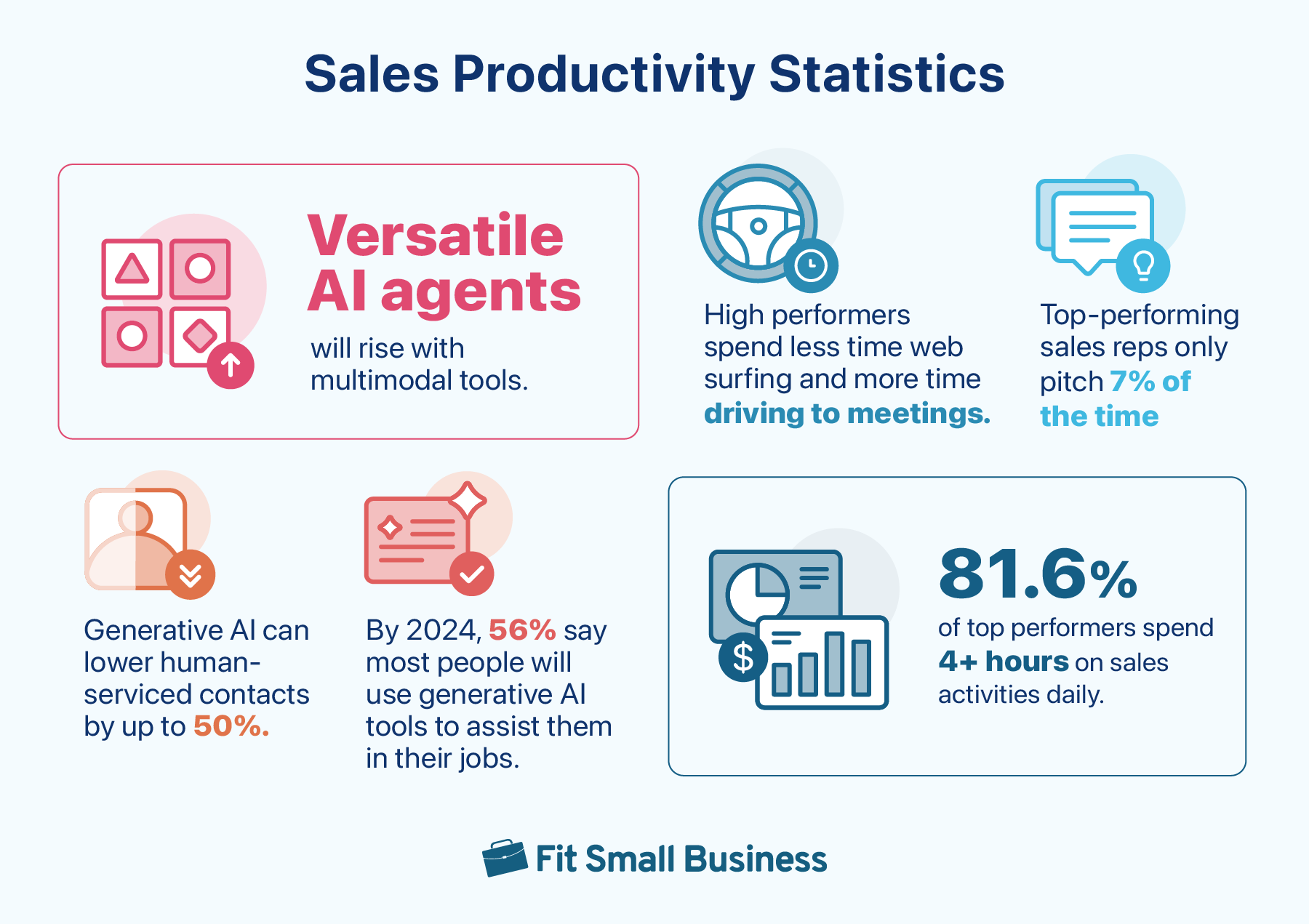
15. Generative AI can lower human-serviced contacts by up to 50%.
Takeaway: Before generative AI came into the mainstream, sales reps manually handled tasks such as lead prospecting and verification, or manual prospect data entry and updating. Now, Generative AI algorithms will take care of these repetitive tasks, allowing agents to spend more quality time on customer interaction, lead nurturing, and closing sales successfully.
(Source: McKinsey)
16. By 2024, 56% say most people will use generative AI tools to assist them in their jobs.
Takeaway: For sales teams, adopting generative AI tools can help them search, qualify, score, and nurture leads, moving prospects quickly to the bottom of the sales funnel to close more deals. Many advanced sales CRM systems already have incorporated AI into their chatbots with the ability to assist agents in creating quick, auto-responses and suggest problem resolutions based on the customer’s data.
(Source: HubSpot)
17. Versatile AI agents will rise with multi-modal tools.
Takeaway: Generative AI (gen-AI) software programs can now help salespeople create email sales copies, live chat responses, and sales enablement or knowledge-based resources. These are also equipped with multi-modal tools that can understand and extract insights from images, videos, audio, and other multiple data types. However, prioritizing human supervision and embedding responsible gen-AI principles throughout the sales process are still necessary to avoid biases and errors.
(Source: Genpact)
18. Top-performing sales reps only pitch 7% of the time.
Takeaway: Sales pitching can be a waste of time if there’s no engagement. So, it’s not surprising why top-performing reps spend significantly more time doing conversational selling rather than giving sales pitches, like what 19% of non-top performers do. They develop a personal relationship instead of constantly pushing a product or service on a lead. It is because buyers want to form bonds with salespeople they view as experts and trusted professionals.
(Source: Sales Insights Lab)
19. High performers spend less time web surfing & more time driving to meetings.
Takeaway: When looking at how high-performing sales reps spend their time compared to their average counterparts, the largest differentials were traveling to meetings and surfing the web. Thirteen percent of top performers find themselves constantly driving to meetings, and 12% spend less time surfing the web than their peers. Motivate your reps to get off their computers and out of the office by scheduling many demos and presentations.
(Source: Sales Insights Lab)
20. 81.6% of top performers spend 4+ hours on sales activities daily.
Takeaway: Another impressive indicator of sales performance is time spent on sales activities like prospecting, demos, presentations, follow-ups, and proposals. Ideally, you should construct your operation to automate, re-assign, or outsource as many non-sales activities as possible like CRM data entry, sales training, or internal team meetings. Checking the sales reports gives managers valuable insights into individual and team sales performance.
(Source: Sales Insights Lab)
Sales Referral Statistics
These business sales statistics are related to how effective referral marketing is to individual reps and the company as a whole. Acquiring business by word-of-mouth recommendations is an effective lead generation strategy for top-quality opportunities and customers.
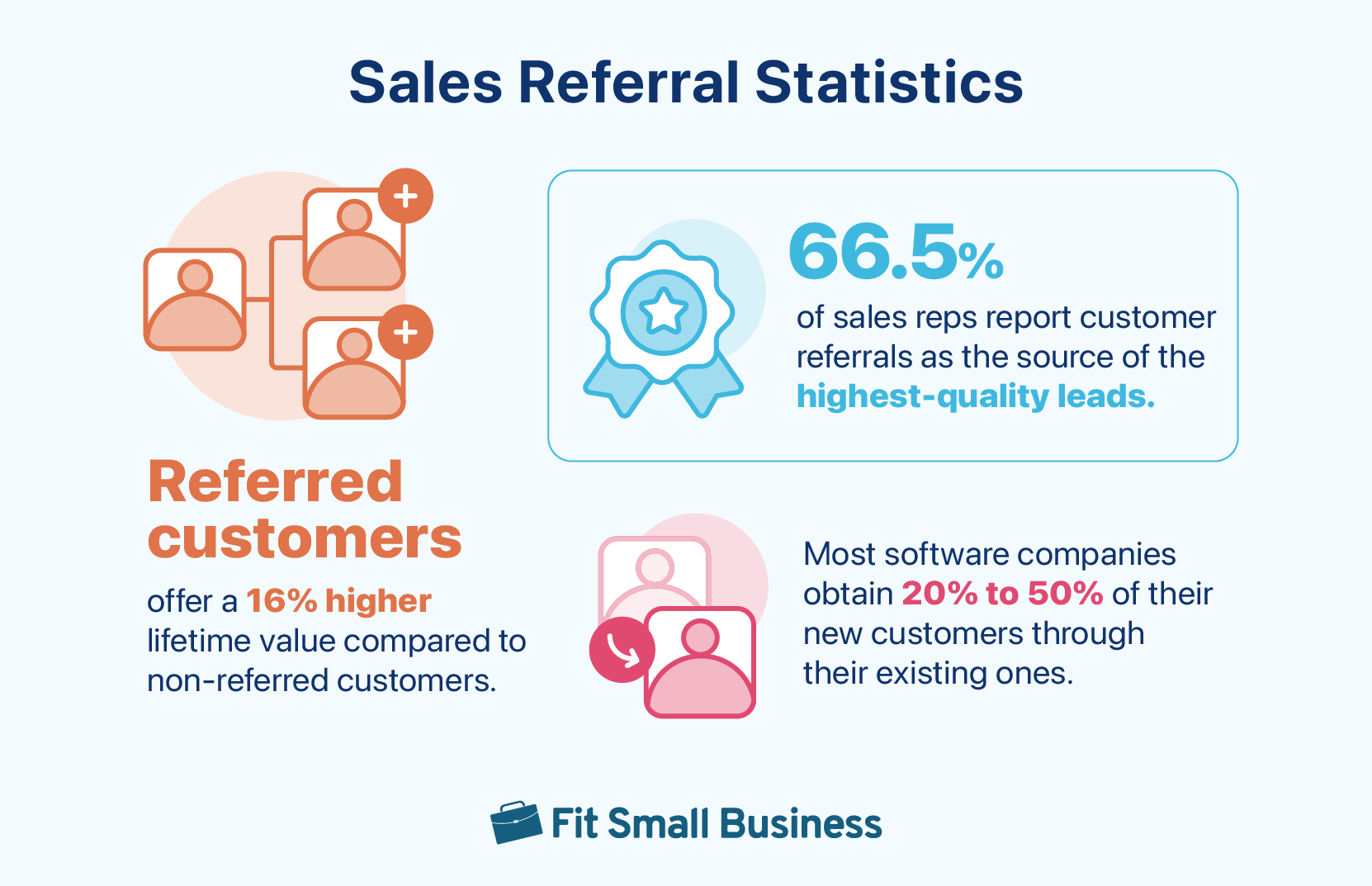
21. Most software companies obtain 20% to 50% of their new customers through their existing ones.
Takeaway: Customer referrals play a significant role in generating new customers for any type of business. Marketing and sales teams can leverage referral strategies to generate new leads. Referrals via word of mouth are particularly helpful for small businesses, especially when coupled with technological solutions like customer relationship management (CRM) software. CRM systems have lead generation and outreach tools to bolster your referral programs.
(Source: DemandSage)
22. 66.5% of sales reps report customer referrals as the source of the highest quality leads.
Takeaway: The implication of this statistic is simple—your sales team should spend plenty of time seeking referrals. Through networking event participants, satisfied customers, or referral sources, reps can request referrals or develop partnerships with complementary businesses to bring in an influx of qualified leads. This route makes your operation more efficient and exceeds the average sales close rate by 20%.
(Source: HubSpot)
23. Referred customers offer a 16% higher lifetime value compared to non-referred customers.
Takeaway: Not only are referred prospects better sales opportunities, they also make ideal long-term clients. Whenever you close a deal and onboard a new customer, developing a robust relationship requires time and effort to fully deliver the solution you promised. If that customer is already coming in from a reliable source, you can expedite the trust-building process and create more valuable, long-term relationships.
(Source: Truelist)
Social Media Sales Stats
When it first became popular, social media platforms were used by marketing teams to build a following and run digital ads. Now, sales reps can leverage these channels to generate leads and develop relationships with potential buyers. Here are some sales stats that incorporate the power of social selling.
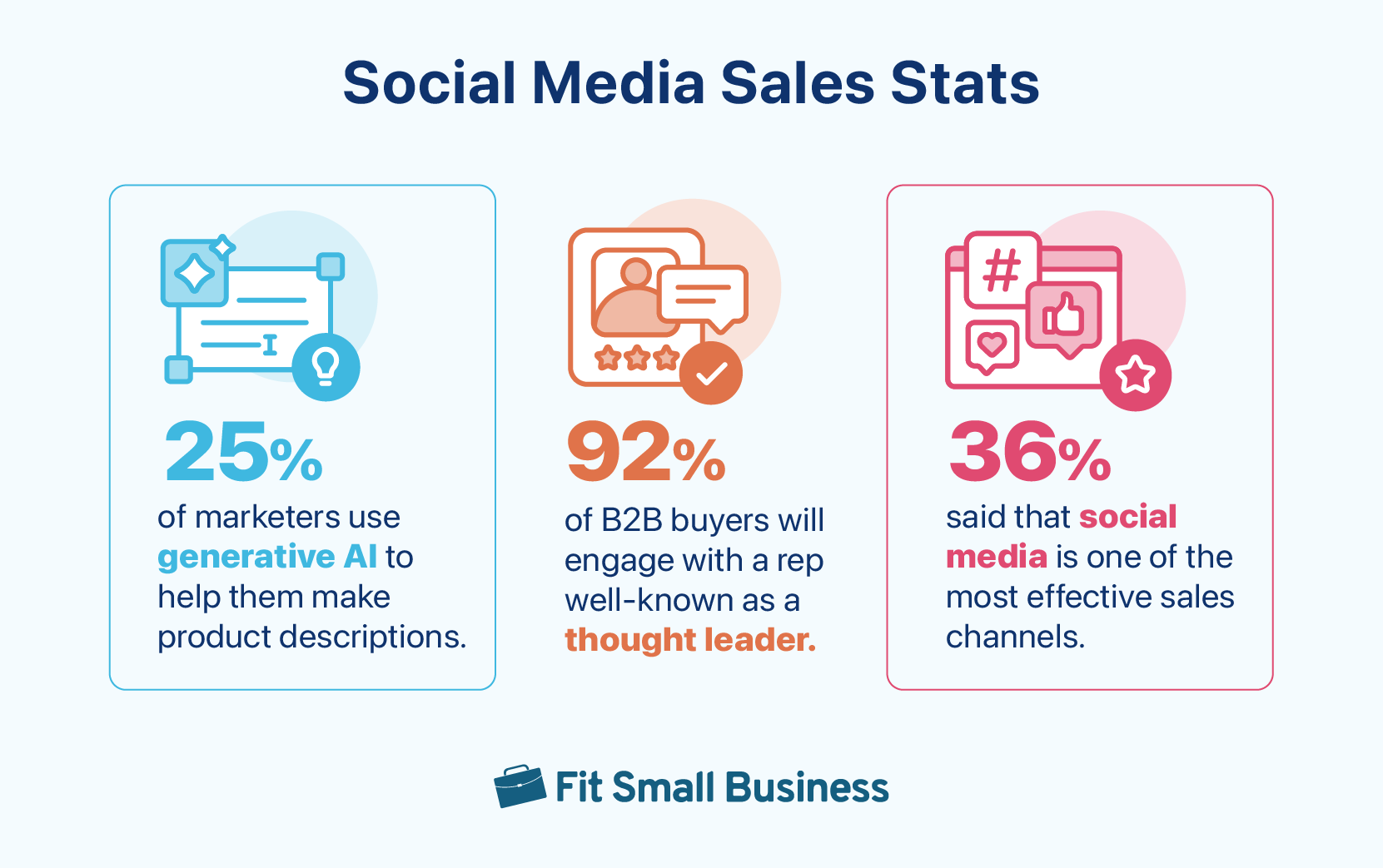
24. 25% of marketers use generative AI to help them make product descriptions
Takeaway: Generative AI plays a crucial role in creating product descriptions for ecommerce websites, shopping apps, and social media commerce. AI can provide suggestions on the best words to describe a product post based on the attached product URL, image, video, or audio content. This technology is also useful in creating social media posts according to 31% of marketers surveyed, and is highly beneficial for sellers wanting to leverage social commerce to boost sales.
(Source: HubSpot)
25. 92% of B2B buyers will engage with a rep who’s well-known as a thought leader.
Takeaway: Most thought leaders are viewed as specialized or innovative experts in a specific market or industry who use social media to communicate their insights. Sales reps, particularly business-to-business (B2B) sellers, can use similar tactics such as product ad gamification or livestreaming to gain a following for leads. Social selling is even more intriguing when you learn that 84% of C-level executives use social media to make purchase choices.
(Source: OptinMonster)
26. 36% said that social media is one of the most effective sales channels.
Takeaway: The most successful sales reps take full advantage of new buyer preferences and use social media sites for research. Not only do nearly all top performers use it, but social sellers are more likely to attain sales quotas than non-social sellers. If you have the budget, it’s a solid investment to provide your sales team with premium accounts on sites such as LinkedIn to help find, generate, and nurture leads.
(Source: HubSpot)
Sales Training Statistics
Sales training statistics detail the importance and implications of consistent sales training. Effective training and coaching ensure reps, both new and experienced, are equipped with the knowledge and skills to sell more efficiently and improve performance.
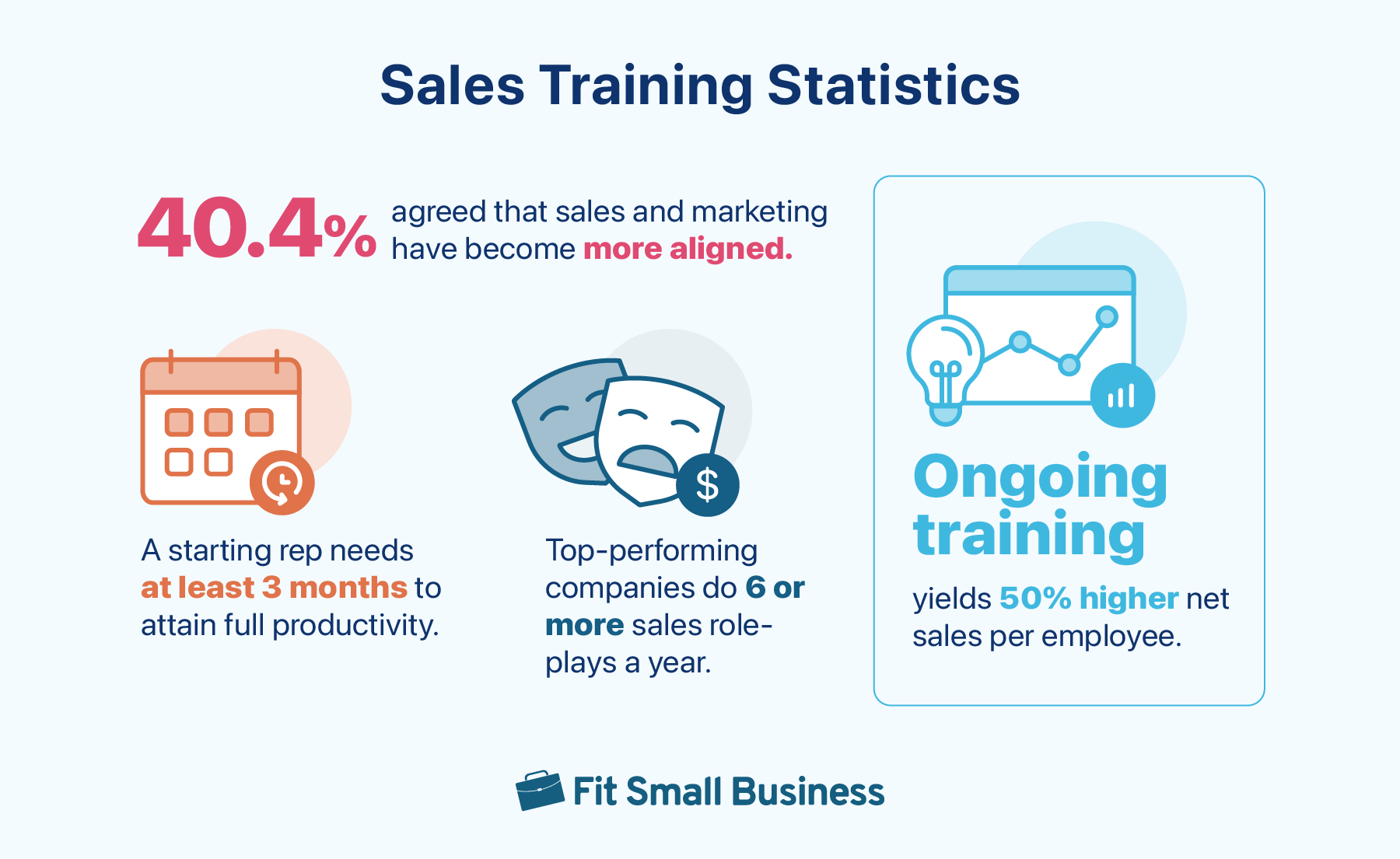
27. Top-performing companies do 6 or more sales role-plays a year.
Takeaway: This sales coaching statistical result shows that sales agents who receive more simulated sales scenario training close more deals. Sales managers must know how to set sales goals considering the type, frequency, and level of training to improve individual and team performance. Otherwise, overall sales performance will remain stagnant or decline.
(Source: Mindtickle)
28. 40.4% agreed that sales & marketing have become more aligned.
Takeaway: Aligning sales and marketing requires effective training so both teams gain a better understanding of shared goals and action plans. If you aim for higher sales rates, invest in sales training programs, which include aligning sales and marketing efforts. Managers can design action plans for sales reps based on their strengths and weaknesses as viewed by performance analytics in CRM and determine how they perceive each department’s role in boosting sales.
(Source: HubSpot)
29. A starting rep needs at least 3 months to attain full productivity.
Takeaway: Be patient with your new sales reps before demanding top-notch performance. You have to add a buffer period to your onboarding process. That doesn’t even take into consideration how difficult it often is to develop a network and base of potential leads and referral partners. Reps need time and continual support before growing into the high-performing team that drives long-term results.
(Source: Xactly)
Bottom Line
As you’re setting sales goals and developing a plan to achieve them, consider these sales statistics when building your framework for success. High-performing reps and teams employ specific habits, technology, training, and lead channels to achieve robust production numbers. It’s essential to remain up to date on sales trends to ensure you’re meeting buyer expectations and taking advantage of the sales tools available to help hit peak performance.